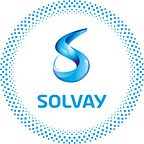Freeze! When industry labs and Nobel Prizes go hand in hand
Sometimes, the line between corporate research and academic research is blurred. The 2018 Nobel Prize in Chemistry illustrates that perfectly, as it was awarded to the discoverers of a technology that Solvay has been using since it was first developed, nearly two decades ago!
CryoTEM is the name. It consists in freezing a liquid solution in nitrogen in order to be able to take a precise picture of its molecular structure with an electronic microscope — hence the name: “Cryo” for the freezing, TEM for “transmission electron microscopy”. That way, scientists can really “see” what they’re working on and finetune their formulations accordingly.
“Chemists and biologists need to visualize at some point what they’re working on,” explains Marc Airiau, R&D engineer at Solvay’s Research & Innovation Center in Aubervilliers, near Paris. “It’s an important method to investigate the structure and the state of dispersion of complex formulations, etc. It delivers information for better understanding.”
It all started with a Styrofoam tray…
In the 1990s, when the team at Solvay’s Aubervilliers lab heard about this new technology developed by Swiss biochemist Jacques Dubochet, they immediately saw it could be useful to their work. “They started out in a very artisanal way, using a Styrofoam tray. But it worked quite well,” recounts Marc. Since then, the technique has of course been perfected, and the R&I Center has become known within the Solvay group as the go-to lab for CryoTEM observations. Another advantage of this method is its rapidity: up to six samples can be prepared, frozen and photographed for observation in one day’s work.
CryoTEM photos can give indications regarding the size and shape of molecular assemblies, the dispersion of mineral aggregates and primary particles, with impacts on the understanding of a product’s properties, because there is simply more to see than with classic electronic microscope observations. The lab recently used the technology to observe iron oxide particles in an additive for diesel motor catalysts, for example. Furthermore, CryoTEM also reduces the failure rate when conducting observations, with the imaginable gains in terms of efficiency.
Connected to academia
True to Solvay’s Open Innovation policy, the lab also uses CryoTEM in the context of collaborations with university researchers. For example, an ongoing partnership with Paris’ Diderot University for Solvay’s business unit Novecare consists in carrying out observations for the development of innovative ingredients for fabric softener formulations under the brand EasySoft; the electronic microscope photos help understand the interactions of the components with cotton.
The R&I Center has also on occasion put its know-how at the disposal of PhD students. “Usually it’s the universities that work for the industry,” says Annie Vacher, the CryoTEM expert at Solvay (and one of only two people who practice the method at the lab, along with Marion Rateau), “but sometimes it’s the other way around! We’ve had the occasion to carry out observations for a doctoral thesis. This means we get included in scientific publications; it’s an opening to the world of academic research, and a way of practicing Open Innovation which allows us all to improve our understanding of complex products.” She even goes further, highlighting the excitement there is in CryoTEM: “I like the constant discovery and even the suspense that is attached to this method. It’s always exciting to discover what the picture will look like, because there’s no way of telling before we actually see it. I’m lucky enough to observe new things every day. There’s no routine with CryoTEM.”
“This is still a quite confidential technique, mostly used by biologists,” says Marc. “The fact we are able to maintain this kind of competence in the industrial world, it’s quite unique.” In a way, Jacques Dubochet’s Nobel Prize reflects on the Solvay experts — and most of all on Annie Vacher, a pioneer who has been practicing the technique for 20 years: “It’s nice to be associated to this kind of acknowledgment. Through CryoTEM, we already had a connection with the world of academic research — now with the world of Nobel Prizes, what a treat!”
This article was originally published on : solvay.com
